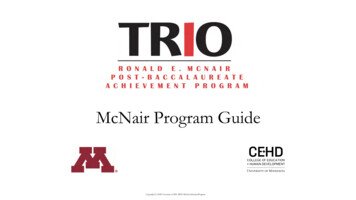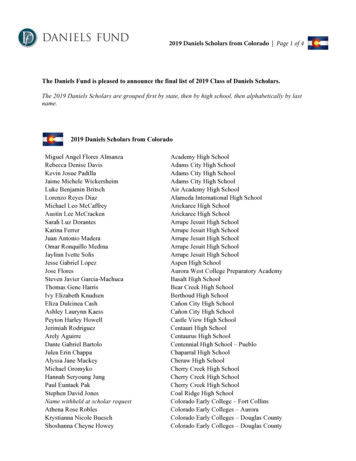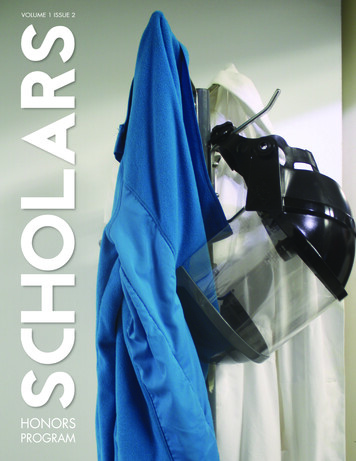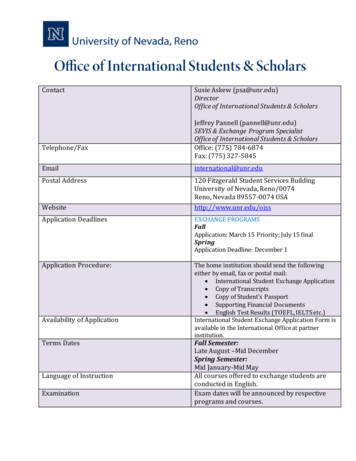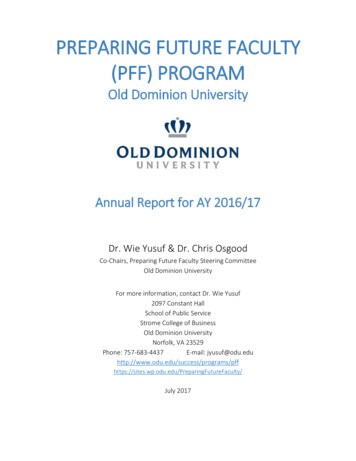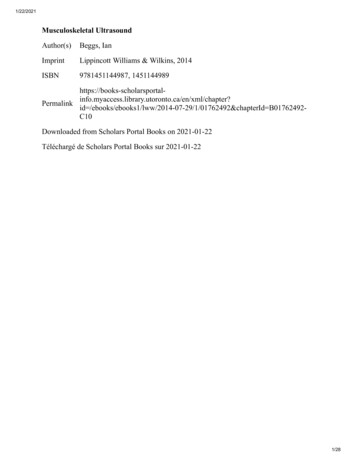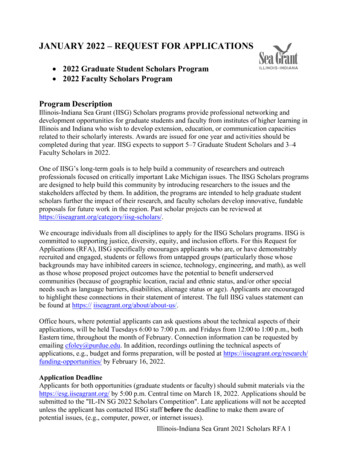
Transcription
International Management ReviewVol. 14 No. 1 2018International Management ReviewVOLUME 14NUMBER 1Dr. Muhammad A. Obeidat, Editor-in-ChiefKennesaw State University, GA, USAExecutive Editorial BoardDr. Max NorthManagement Information SystemsKennesaw State University, GAUSADr. Ahmad KhanUniversity of Phoenix, AZ, USAEditorial Review Board AdvisorsDr. David J. ReibsteinProfessor of MarketingThe Wharton SchoolUniversity of Pennsylvania, USADr. Javed AshrafDean, University of St. Thomas,USAManaging EditorDr. Linda SunKennesaw State University, GA, USADr. Stephen J. HavlovicProfessor and VP of AcademicAffairs. Alfred State College,Alfred, NY, USADr. Venkat ReddyInterim Dean, University ofColorado at Colorado Springs, USADr. Wayne MarrDean, University of Alaska atFairbanks, USADr. Stanisław StrzelczakAssistant Dean, Warsaw Universityof Technology, PolandDr. Monica Nandan,Department of Social Work andHuman Services,Kennesaw State University, USADr. Khamis Bilbeisi, AssistantDean, Troy State University Dothan,USADr. Amine Nehari-TaletKing Fahd University of Petroleumand Minerals, SADr. Ian GladdingProfessor of International BusinessLewis University, IL, USADr. Hani Abu-SalemDePaul University, USADr. Haidar FraihatKing Fahd University of Petroleumand Minerals, SAEditorial Review BoardDr. Yakubu UmarKing Fahd University of Petroleumand Minerals, SADr. Shi Kan, DirectorChinese Academy of Sciences,Beijing, ChinaDr. Ahmad Abu-MusaKing Fahd University of Petroleumand Minerals, SADr. Nabil GhallebCollege of Industrial ManagementKing Fahd University of Petroleum& Minerals, SADr. Sarah M. NorthDepartment of Computer ScienceKennesaw State UniversityDr. Chen Yan, DirectorDalian Maritime University, ChinaDr. Syed ImamAmerican University, Cairo, EgyptDr. Willie E. HopkinsDean College of BusinessCalifornia State University – Chico,USADr. Ahmad Al-rfouTafilah Technical University, JordanDr. Musa M. DaraysehPurdue University Calumet, USADr. Muhammad Asad SadiKing Fahd University of Petroleumand Minerals, SADr. Choi Sang longSouthern College Malaysia, Malaysia1
International Management ReviewVol. 14 No. 1 2018Call for PapersThe International Management Review (IMR) journal invites the submission of papers for publicationconsideration for coming issues in 2018. IMR publishes both empirical and conceptual papers. Articles inIMR address emerging trends and concerns in the areas of Management Science and EngineeringAccountingFinanceEconomicsInformation TechnologyBusiness EducationBusiness Distance LearningBusiness LawMarketingOperations ManagementManagement Information SystemsQuality ManagementInternational Business/TradeHuman Resource ManagementProject ManagementManagement of TechnologyPublic AdministrationStrategic ManagementEntrepreneurshipHealth Care Managemente-BusinessOther topics approved by editorThe goal of IMR is to facilitate management knowledge exchange among researchers and practitioners.IMR also publishes scholarly research.Manuscripts: The journal accepts unsolicited manuscripts. All articles are blind peer-reviewed. The journalreserves the right to make all decisions regarding the acceptance or rejection of an article for publication.All editing decisions reside with the journal's editorial board.Submission: Manuscripts must comply with the journal’s specified format and style and must be submittedin Microsoft Word. Please e-mail your manuscript to mobeidat@kennesaw.edu or lsun6@kennesaw.eduwith a letter indicating the appropriate track for your paper.Website: www.americanscholarspress.us2
International Management ReviewVol. 14 No. 1 2018This Page is left blank purposely.3
International Management ReviewVol. 14 No. 1 2018TABLE OF CONTENTSThe Role of Information Technology Capability and Innovative Capability: An EmpiricalAnalysis of Knowledge Management in HealthcareChristie Hui-chuan Chen and Tommy Cates .5A Review and Assessment of the Existing Health Consciousness ModelsJin Zhang, Li Sun, and Ahmad Khan .20Expecting more out of Expectancy Theory: History urges inclusion of the social contextRobert Lloyd and Daniel Mertens .28Analysis of Effectiveness of Optional Versus Mandatory Quizzes on Final ComprehensiveExaminations PerformanceMax North and Ronny Richardson 44Establishing and Analyzing Commercial Banks’ Carbon Finance Business Revenue ModelXu Dawei and Zhao Peng .49Construction of Performance Evaluation System for Public Projects Based on PublicSatisfactionLiu Man and Jiang Qifa 56Book Chapter 14: The Philosopher: Feasible or Desirable----Foresight and Extreme Creativity Strategy for the 21st CenturyLangdon Morris 634
International Management ReviewVol. 14 No. 1 2018The Role of Information Technology Capability and Innovative Capability:An Empirical Analysis of Knowledge Management in HealthcareChristie Hui-chuan Chen and Tommy CatesCollege of Business and Global Affairs,University of Tennessee at Martin, Tennesseehchen38@utm.edu; tcates@utm.edu[Abstract] The majority of existing research studies of long-term care sectors has focused on reducingdeficiencies and improving quality. The objective of this current study is to investigate how informationtechnology capability affects innovative capability and knowledge management in the long-term healthcaresector. Our findings indicate that IT and innovative capabilities are associated with facilities’ knowledgemanagement capability in the U.S. long-term care sector. Hence, the success of healthcare depends criticallyon the utilization of information technology capability and innovative capability to collect, analyze, andexchange knowledge within and across organizational boundaries.[Keywords] Information technology capability, innovative capability, knowledge management, healthcare,healthcare information technologyIntroductionStrategic management of organizations depends on the development of distinctive competencies toimprove performance over competing organizations and to serve customers. The ability to improveoperations across all functions creates competency that leads to long-term survival and success. Informationtechnology (IT) capabilities reflect the ability to support all parts of the organization while improvingconnectedness to the supply chain. Research seeks to determine the improvements that technology bringsto various organizations. Melville et al. (2004) suggested that a broader approach was needed toconceptualize the value of IT in improving business efficiency and effectiveness. Notably, the value that ITadds to businesses continues to be the focus of upper-level managers within organizations. A broad list ofapproaches has specified the processes by which value is added to businesses via IT and the impact of thisvalue on organizations. These approaches include the contributions of IT to organizational performance(Luftman et al., 2017), to internal managerial practices (Dalkir & Beaulieu, 2017), to competitive pressure(Oyemomi et al., 2016), and to supplier and customer collaboration (Liu et al., 2016).Recently, the federal government, insurers, and employers have increased pressure for healthcareproviders to be more efficient and effective in their operations. These cost pressures have led to strongcompetition among the various providers. Administrators and providers are looking to informationtechnology to assist in providing better care at lower costs. New information technologies allowedhealthcare providers to search for ways to improve the quality of care and operational efficiency (Bose,2003). Thus, increased efficiency has allowed decision makers to reduce insurance premiums while findingthe best utilization of resources for patient care. As service organizations, healthcare entities utilize healthinformation technology (HIT) to improve both the quality and efficiency of decision making (Chaudhry etal., 2006). The exponential growth of available data and rapid changes in healthcare technology offer5
International Management ReviewVol. 14 No. 1 2018substantial opportunities in IT. To ensure that the organization purchases the information technology whichfosters the best overall value, a sustainable strategy is needed to match the organization’s needs to the ITsystem’s capabilities, along with a plan to maintain evaluation of the IT capability (Leung, 2012).Therefore, top management is responsible for altering the norms and culture as a means of encouragingand influencing members to adapt to innovative technology (Chen & Prater, 2014). Earlier, García Moralesand Lloréns Montes (2006) studied organizational innovation which revealed that innovative firms not onlyrespond to the environment but also create it. Such innovative behavior is achieved by taking a proactiveattitude of bringing together teams of innovative members while building on the firm’s innovativecapability. The concept of firm innovativeness refers to cooperation within the firm’s environment topromote and support novel ideas. When organizations practice an innovation-based strategy to obtainspecific capabilities, such behavior distinguishes these firms from their competitors via timely, appropriatereactions to variability in the environment. Therefore, innovative capabilities often lead an organization toincrease performance (Ferraris et al., 2017).The sum of the knowledge available within an organization should develop competency through ITcapability and innovative capability. The integrated nature of the entire knowledge management capabilitiesmay impact organizational performance. In fact, knowledge management capability is associated withknowledge acquisition, knowledge conversion, knowledge application, and knowledge protection (Gold etal., 2001). Typically, firms seeking to enhance their overall capabilities should first decide on necessaryapplications, then move to decisions about infrastructure and other required processes in support of thespecific application (e.g., how knowledge will be acquired, converted and protected). Focusing onindividual knowledge processes provides a more fundamental understanding of a firm’s knowledgemanagement capability while enhancing management decision-making at the resource level (Mills & Smith,2011). Thus, HIT cannot function well as an independent entity. Rather, it is a collaboration amongphysicians, nurses, administrators, and other staff members using their complementary skills to determinewhether HIT can be successfully adopted by a group of healthcare organizations. For health administrators,fostering a collaborative culture among staff members is essential when adopting HIT (Leung, 2012). Assuch, the involvement of each stakeholder is essential for the HIT to develop its full potential, and toencourage the maximum contribution of the competitive posture of the organization.Most of the previous research studies of long-term care sectors has focused on reducing deficienciesand improving quality (Chesteen et al., 2005). This current study provides a different view of the innovativeaspect of implementing information technology in the long-term care setting. The environment of nursinghome care has been defined as “low-tech” and high personal contact (Lenard & Shimshak, 2009). Therefore,assessing how nursing facilities increase their investment and implementation of information technologyacross facilities will be a major challenge. The objective of this current study is to investigate howinformation technology capability affects innovative capability and knowledge management in the longterm healthcare sector. The US healthcare industry is increasingly becoming an integrated, knowledgebased community connecting hospitals, clinics, pharmacies, insurance, and customers for sharingknowledge, reducing administrative costs and improving the quality of care. Based on the strategicobjectives of an organization, knowledge management should identify, capture, structure, and shareinformation to help nursing facilities offer better service, thereby enabling the organization to achievecompetitive advantages. Hence, the success of healthcare depends critically on the utilization of information6
International Management ReviewVol. 14 No. 1 2018technology capability and innovative capability to collect, analyze, and exchange knowledge within andacross organizational boundaries.Literature Review and HypothesesFigure 1 provides the research model for this present study. The literature review and research hypothesesfor our current study include an evaluation of the theory based on causal relationships among IT capability,Innovative capability, along with Knowledge management in both Information & data as well as Analysis& usage.KnowledgeManagementH2Information & dgeManagementAnalysis & UsageFigure 1. Research frameworkInformation Technology CapabilityInformation technology capability was derived from a resource-based perspective; however,the resource-based view involves a very broad view of assets, knowledge, capabilities, and organizationalprocesses into tangible, intangible, and personnel-based resources (Grant, 1991). Information technologycapability is defined as the “ability to mobilize and deploy IT-based resources in combination or co-presentwith other resource and capabilities” (Bharadwaj, 2000, p. 171). Thus, IT capability can be classified intophysical IT infrastructure; human IT in technical and managerial skills; and intangible IT in knowledgeassets (Grant, 1991, Mill and Smith, 2011). Moreover, Lu and Ramamurthy (2011) conceptualized threedifferent dimensions of IT capabilities: (1) IT infrastructure capability, (2) IT business spanning capability,and (3) IT proactive stance. Firstly, IT infrastructure capability is the firm’s ability to share and managedata, services, network, and applications. Second, IT business spanning capability is the firm’s ability tomaintain and advance business objectives by foreseeing and exploiting IT resources. Thirdly, an ITproactive stance is the firm’s ability to develop IT innovation and seek new opportunities to enhance ITeffectiveness. Lu and Ramamurthy further stated that IT capability provided a joint effect on spendingresources regarding agility in operational adjustments. In other words, more IT spending or investing inoperational agility tends to enhance and foster IT capabilities.7
International Management ReviewVol. 14 No. 1 2018A firm’s technology may seem like a simple “make versus buy” decision; however, at a deeper level,sourcing activities reveal its preference for combining internal and external sources of new and existingknowledge. When aggregating each technology sourcing decision up to the firm level, however, uppermanagement must decide on how to balance internal and external technology sourcing simultaneously. Thecritical issue lies within the managers’ decisions regarding the preferred focus on internal versus externaltechnology sourcing, and how this balance is dynamically adjusted considering changing conditions andthe resources and capabilities available during a particular time frame. The capacity to do so is captured byour understanding of ambidexterity as a firm’s ability to simultaneously balance different activities in atrade-off situation (Rothaermel & Alexandre, 2009).Many studies have shown that IT investments have significantly improved the productivity and quality(Chen and Prater, 2013; Sher and Lee, 2004). Moreover, several studies have investigated the case for ITand quality. In fact, one major outcome of HIT on the quality of care arises in increasing observance ofguidelines or protocol-based care (Chaudhry et al., 2006). Specifically, the nursing home industry reportsMedicare and Medicaid financial information and quality indicators to speed up the reimbursementprocesses. When environmental changes are more predictable, firms tend to devote resources to technologyinternally. In an earlier study, Devaraj and Kohli (2000) noted that investing in technology for businessprocess re-engineering supports the long-term performance of hospitals. Such re-engineering efforts mayrelate to all aspects of the organization, including human resources and patient quality improvements.Furthermore, Chaudhry et al., (2006) confirm that higher investment in technology compared to similarlocation and size of other competitors will improve the facilities’ performance. Conversely, Lu andRamamurthy (2011) argue that investment in IT may hinder organizational performance and that ITcapability requires support to avoid such negative effects. They maintain that significant investment in ITmight not necessarily improve agility especially when such investments are not focused on fostering andincreasing IT capability. However, they noted that wise IT investment successfully improves andstrengthens critical IT capabilities.Innovative CapabilityThe innovative capability is defined as the ability of the firm to develop new products and markets,through aligning an innovative strategic orientation with innovative behaviors and processes (Wang andAhmed, 2007). The concept of innovative capability is multidimensional; specifically, these dimensionshave been studied by numerous researchers regarding new products or services (Daneels, 2002), planningstrategic marketing technology (Capon et al., 1992), and enhancing R&D of pharmaceutical firms (E’Este,2002). Other studies (e.g., Delmas 1999; Lazonick & Prencipe 2005) also reveal that in several industries,the innovative capability is a critical factor in the firms’ evolution and survival considering externalcompetition and change. Thus, the more innovative a firm is, the more it possesses dynamic capabilities.As in many matters of management practice, Drucker (1954) was one of the first to call for researchinto the importance of innovation. The concept of innovation involves the degree to which an individual (ina social system) adopts something new (Calantone et al., 2002). While this focuses on an individual, Hurleyand Hult (1998) discussed the organizational perspective of openness to new ideas as an aspect of a firm’sculture. The concept of firm innovativeness includes two areas: 1) the rate of adoption of innovation by thefirm, and 2) the firm’s willingness to change. The standard classification of innovation delineates between8
International Management ReviewVol. 14 No. 1 2018incremental versus radical paths (Dewar & Subramaniam & Youndt, 2005). Incremental innovation is acontinuous path of improving and refining the firm’s existing products, services or technologies.Conversely, radical innovation represents a non-continuous path involving the major transformation ofcurrent products, services or technologies.Changes in technology within product and service innovation was first studied by Comanor (1965) inthe pharmaceutical industry to determine the effect of a firm’s long-term financial performance.Organizations implement useful ideas to create innovative capabilities; furthermore, firms often acquireinnovation through adaptation of products or processes via external organizations. Government regulationor intervention in markets may act as an enhancer (e.g., patents for chemicals and pharmaceuticalindustries), or as an inhibitor of innovation in protected markets (Holloman, 1979). As a method ofsupporting higher long-run performance, Teece (2007) noted that invention, innovation, and manufacturingcapability could enhance enterprise performance and encourage higher profits. The sourcing of technologyrelated to organizational and technological boundaries involve two important delineations (Rothaermel &Alexandre, 2009). These delineations are (1) sourcing of known versus new technology, and (2) internalversus external sources of technology. Typically, the information technology capability within the firmassists the organization to become more innovative. Thus, we propose:Hypothesis 1: Information technology capability is related to innovative capability.Knowledge Management CapabilityA model of knowledge management has been proposed by Gold et al. (2001). Gold et al. theorizedknowledge management capabilities as multidimensional concepts that incorporate a process perspectivefocused on a set of activities. Knowledge process capabilities and an infrastructure perspective should focuson enablers (i.e., knowledge infrastructure capabilities). These, in turn, are composed of multipledimensions: knowledge infrastructural capability comprises technology, organizational culture, andstructure while knowledge process capability is made up of knowledge acquisition, knowledge conversion,knowledge application, and knowledge protection (Mills & Smith, 2011). In an earlier study, Jensen andMeckling (1995) defined specific knowledge as knowledge that is expensive to transfer among agents,whereas general knowledge is inexpensive to convey. Due to its high transfer costs, obtaining specificknowledge for decision-making involves decentralizing many decision rights. Such allocation, in turn,creates two issues: the rights assignment issue (determining who should exercise a decision right), and thecontrol or agency issue (how to confirm that self-interested decision agents implement their rights in a waythat contributes to the organizational goal).The main distinction between information management and knowledge management is that the contentof each is different; specifically, knowledge management is less structured and utilizes informal problemsolving expertise and experience rather than being limited to automated processing and data manipulationas seen in information management (Bose, 2003). Development of knowledge management includes (1)careful identification of the target user community and its needs, (2) meta information that defines the typesof information to be included and how they will be categorized and summarized, and (3) administrativetools providing quality control and high availability. The commonly used terms of information andknowledge build on each other conceptually. In general, accumulation of transactional data into a9
International Management ReviewVol. 14 No. 1 2018meaningful context produces information. Next, moving this information to a higher level is characterizedby knowledge. Knowledge is gained through managing information effectively and efficiently throughproper cataloging and structuring the data. Finally, the highest level of knowledge is gained by processingthe information on a timely basis and giving access to the right decision makers (Bose, 2002).The technology component of knowledge infrastructure is the information technology (IT) system thatencourages the integration of information and knowledge in the firm, as well as the creation, transfer,storage, and security of the knowledge resources. Nevertheless, the links between information technologiesand measures of organizational performance have not been found in research. The research efforts have notdemonstrated whether IT is directly related to performance (Powell & Dent-Micallef, 1997); IT alone doesnot improve organizational performance, but once IT is combined with human and business assets,organizational performance was enhanced. Teece (2007) noted that an absence of an association betweentechnology and performance could be due to the technology being copied by other firms, making it a shortlived competitive advantage. Although technology infrastructure is not directly related to organizationalperformance, it enables other knowledge resources (e.g., knowledge acquisition and knowledge applicationprocesses) to enhance organizational performance (Mills & Smith, 2011). The infrastructure of a welldesigned knowledge management system facilitates creation and management of e-business knowledge thatimproves back-office efficiency, provides greater customer intimacy, and encourages flexible adaptation tomarket changes. Specifically, the volatility of the current healthcare environment forces healthorganizations to invest in knowledge management and establish processes and infrastructure necessary tocreate and manage e-health knowledge (Bose, 2002). Therefore, we propose:Hypothesis 2: Information technology capability is related to knowledge management of informationand data.Big data may help with some of the required knowledge dissemination. As an example, physiciansstruggle to treat a reasonable number of patients and remain current with the latest and best evidence toguide their clinical practice. Digitization of medical literature improves access, but the sheer number ofstudies and their inherent differences regarding findings makes it difficult to apply the research into practice.Even if clinicians obtained all the relevant evidence and guidelines, sorting through that information istime-consuming (Leung, 2012). Certainly, treating a patient with multiple illnesses is even morecomplicated. The big data approach differs from traditional decision support tools in that suggestions aredrawn from real-time patient data analysis, rather than solely using rule-based decision trees. For example,longitudinal diagnostic data have been shown to predict a patient’s risk of a future diagnosis of domesticabuse (Murdoch & Detsky, 2013). Moreover, data-driven analysis with clinical decision support tools couldalso lead to cost savings and help with appropriate standardization of care. Hence, we propose:Hypothesis 3: Information technology capability is related to knowledge management in analysis andusage.Organizations create value by applying knowledge of their products and services by different means.Similarly, Mill and Smith (2011, pp. 160) stated that: “knowledge application means making knowledgemore active and relevant for the firm in creating value.” Knowledge creation can be accomplished by10
International Management ReviewVol. 14 No. 1 2018repackaging available knowledge, training and encouraging employees to think creatively. Furthermore,employees must demonstrate an understanding of the processes, products, and services offered by thefacility. Ideally, organizations support organizational learning among groups or individuals as a way ofdeveloping knowledge in new product ideas, thereby leading to improved speed to market and innovation(Daneels, 2002). Mill and Smith stated that knowledge management capabilities had been found to affectinnovation and organizational effectiveness. For example, a firm’s knowledge boundary determines thegeneral direction of the innovative process. The main consideration is whether to use incrementalinnovation currently within the firm or to seek radical new technology. Although the incremental approachuses existing technology, the methods or materials used can still show discernable improvements. In fact,the pharmaceutical industry’s attempts to incorporate biotechnology, a radical process innovation, into theirmethods of drug discovery and development serve as a good example (Rothaermel & Alexandre, 2009).Institutionalization of the firm’s capability to preserve knowledge and the mechanisms to maintain thisstatus quo are visible in its organizational capital. Organizational capital is exemplified by manuals,databases, patents, and licenses to solidify and preserve the knowledge bases with structures, processes,and routines that encourage repeated use of the knowledge (Subramaniam & Youndt, 2005). Moreover,when healthcare becomes more innovative by implementing its healthcare information system as acollection of firm’s information and data, the healthcare provider can potentially become a driving force insystem-wide reconfiguration by encouraging reformulation of policies, reorganization of staff, etc. Throughapplying the data and information from the HIT, administrators may apply the knowledge to improveorganizational routines and practices (Leung, 2012). Based on the organizational capital of information anddata, it is believed that the firm’s prevailing knowledge reinforces prevailing knowledge and influences itsincremental innovative capabilities. As such, we propose:Hypothesis 4: Innovative capability is related to knowledge management in information and data.Hypothesis 5: Innovative capability is related to knowledge management in analysis and usage.Research MethodologyData Collection and Factor AnalysisAll measurement items were obtained from previous test questionnaires; therefore, no newlydeveloped scales were used for this study. The research model and survey items were evaluated andapproved by operations management faculty and other management professors. The questionnaires werealso examined by seven administrators of skilled nursing facilities to ensure face validity. A few minorchanges in wording were done to better align with the healthcare - nursing home sector. 1,500 surveys weresent out via US Mail to the administrators of skilled nursing facilities which receive Medicare and Medicaidreimbursement. Therefore, individual skilled nursing facilities are the unit of analysis for this study; as such,the unit of analysis is at the firm-level. The survey items reflect information technology capability,innovative capability, knowledge management in information and data, and knowledge management inanalysis and usage.We received a total of 264 surveys. Some surveys were excluded from the analysis due to one or moreof the following reasons: incorrect mailing address, administrator’s unwillingness to share information, and11
International Management ReviewVol. 14 No. 1 2018missing more than 20% of the survey items. Additionally, we omitted the surveys received from facilitieswith less than 30 beds due to staffing characteristics with low signal-to-noise ratios which should not beincluded in the analysis (Castle & Engberg, 2008). A total of 199 valid surveys were received
Kennesaw State University, GA, USA Editorial Review Board Advisors Dr. David J. Reibstein Professor of Marketing . The Wharton School . . California State University - Chico, USA . Editorial Review Board . Dr. Stanisław Strzelczak. Dr. Assistant Dean, Warsaw University of Technology, Poland. Monica Nandan,
